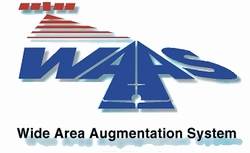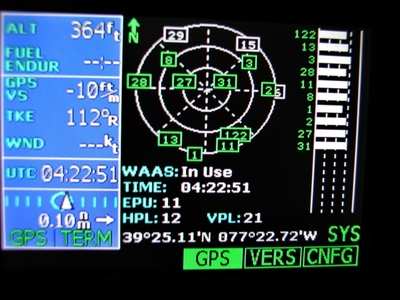An Electronic Glideslope To Your Airport, Today!
 An ILS approach is the easiest and
safest kind of approach. Even for a VFR pilot, following the ILS
needles at night is a guarantee you won't hit anything unseen on
your way down to the runway. However, only a little more than 700
airports in the United States have a traditional instrument landing
system.
An ILS approach is the easiest and
safest kind of approach. Even for a VFR pilot, following the ILS
needles at night is a guarantee you won't hit anything unseen on
your way down to the runway. However, only a little more than 700
airports in the United States have a traditional instrument landing
system.
"But with WAAS-certified avionics, you could most likely fly an
ILS-like approach into your airport today, even if it's one of the
4,400 general aviation airports without an ILS," said AOPA
President Phil Boyer.
"If your airport has a straight-in GPS approach, it probably has
vertical guidance built in to the WAAS database," Boyer. "You can
fly this 'pseudo' glideslope just like an ILS, with advisory
vertical guidance to the visual descent point or the missed
approach point."
AOPA has been pushing for WAAS —- the wide area
augmentation system —- for almost a decade. This year, AOPA
successfully lobbied Congress for full funding —- some $100
million —- for continued WAAS development and operations. The
association also obtained a congressional directive to FAA to
develop more WAAS approaches to general aviation airports.
But there are already literally thousands of approaches that can
be flown like an ILS right now.
The WAAS system improves the accuracy, availability,
reliability, and integrity of the GPS signal. GPS-WAAS can be used
as the sole means of navigation in all flight phases, including
vertical guidance on most nonprecision GPS instrument approaches.
Additionally, a brand-new type of approach, the LPV instrument
approach, provides minimums rivaling traditional ILS systems
without the $1.5 million-plus costs of an ILS installation.
The FAA certified WAAS for instrument flight in July 2003.
The first receiver certified to take full advantage of the WAAS
signal with vertical guidance is the Garmin GNS480 (or Apollo CNX80
with the version 2.0 upgrade). Garmin announced that milestone at
AOPA Expo in October 2004, and the company expects to have WAAS
upgrades for its GSN430/530 and G1000 in 2005.
Chelton Flight Systems' FlightLogic EFIS (electronic flight
information system) is currently capable of flying approaches to
LNAV/VNAV minimums, using baro VNAV with the corresponding very
cold temperature limitations. The FreeFlight GPS used by the EFIS
will be LPV-capable by summer 2005.
Honeywell has developed a WAAS "engine" and plans its first
delivery of WAAS-capable equipment in the Apex EFIS next year.
Other Honeywell Bendix/King products will get WAAS shortly
thereafter.
Numerous handheld GPS receivers can also receive the more
accurate WAAS signal, but handhelds may not be used for navigation
in instrument conditions.
"I've been involved in this WAAS project for over nine years,
and there were many times Congress wanted to kill it," AOPA
President Phil Boyer said during a press conference at AOPA Expo.
"About four years ago, AOPA brought the industry and FAA together
in one room and said, 'Let's not let anybody out of here until we
can go to Congress with an honest answer — will it work and
how much will it cost?'"
The answer was, yes, it will work. The technical difficulties of
improving the GPS signal proved greater than originally thought,
particularly coupled with an FAA demand that the system be more
accurate and reliable than existing VORs and ILSs. It took longer
to build, and it will cost more than early estimates — a
total of about $3 billion over 25 years.

"This is the culmination of phase one," Boyer said, "and the
benefits for the single pilot hand-flying IFR are tremendous.
There's nothing better than following two rock-solid needles like
an ILS, rather than a wiggly VOR needle or an ADF.
"That also means you can fly every approach the same way, just
like an ILS," said Boyer. "That's a tremendous workload reduction,
not to mention the safety benefit. Because you can standardize your
approach procedures, there is less likelihood of making a
mistake."
And there are thousands of these approaches you can fly today
with the right equipment.
 ANN's Daily Aero-Term (04.14.24): Maximum Authorized Altitude
ANN's Daily Aero-Term (04.14.24): Maximum Authorized Altitude ANN's Daily Aero-Linx (04.14.24)
ANN's Daily Aero-Linx (04.14.24) Classic Aero-TV: 'We're Surviving'-- Kyle Franklin Describes Airshow Life 2013
Classic Aero-TV: 'We're Surviving'-- Kyle Franklin Describes Airshow Life 2013 Aero-News: Quote of the Day (04.14.24)
Aero-News: Quote of the Day (04.14.24) Airborne 04.09.24: SnF24!, Piper-DeltaHawk!, Fisher Update, Junkers
Airborne 04.09.24: SnF24!, Piper-DeltaHawk!, Fisher Update, Junkers




